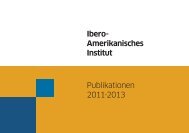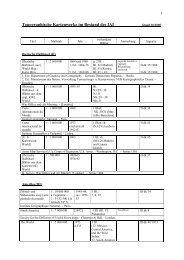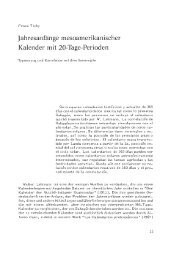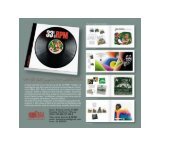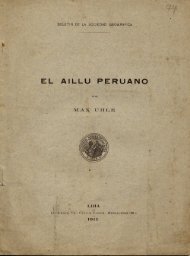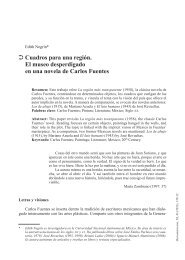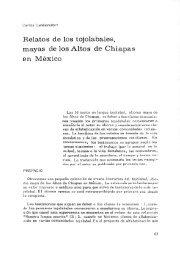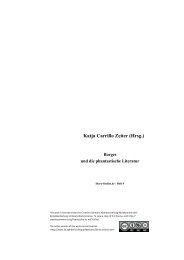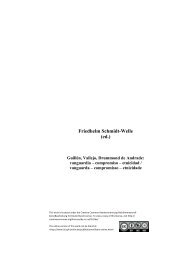Mário de Andrade: On Being São Paulo-wise in Paulicéia desvairada
Mário de Andrade: On Being São Paulo-wise in Paulicéia desvairada
Mário de Andrade: On Being São Paulo-wise in Paulicéia desvairada
You also want an ePaper? Increase the reach of your titles
YUMPU automatically turns print PDFs into web optimized ePapers that Google loves.
Rev19-01 22/8/05 13:17 Pág<strong>in</strong>a 38<br />
38 David William Foster<br />
health on the mud tracks of a forgotten village, but here specific mention is ma<strong>de</strong> of one<br />
of the s<strong>in</strong>gular characteristics of the built environment of the urban landscape, the paved<br />
street, although such an improvement for transportation is not without its problematical<br />
aspects, and such <strong>in</strong>stallations are rarely kept up, <strong>in</strong> the sprawl<strong>in</strong>g environment of the<br />
Lat<strong>in</strong> American megalopolis, <strong>in</strong> optimum conditions. There are often potholes and open<br />
trenches that have been there for so long that they veritably <strong>de</strong>serve a bronze plaque as<br />
national monuments to the problems of ma<strong>in</strong>ta<strong>in</strong><strong>in</strong>g the <strong>in</strong>frastructure of the city. Another<br />
<strong>de</strong>tail of the problematical <strong>in</strong>frastructure of the city is that of stand<strong>in</strong>g or trickl<strong>in</strong>g fetid<br />
water, an example of the imperfectly or <strong>in</strong>completely channeled waste that is as much<br />
that of the occupants of the city as it is of the <strong>in</strong>stallations of their built environment (that<br />
is, as much a problem of leak<strong>in</strong>g “used” or “black” water as it is of leak<strong>in</strong>g <strong>in</strong>com<strong>in</strong>g<br />
“white” water that often becomes contam<strong>in</strong>ated by the construction substances of build<strong>in</strong>gs).<br />
Andra<strong>de</strong> here uses that water as a metaphor for the nameless tears of the occupants<br />
of neighborhoods of the unfortunate <strong>in</strong>to which the “count” has ventured: “Estas paragens<br />
trevas <strong>de</strong> silêncio...”<br />
The sentimentality to which “Colloque sentimental” refers is hardly of the sublime<br />
or<strong>de</strong>r of Romantic poetry – if I may once aga<strong>in</strong> restrict the characterization Lowe (1982)<br />
makes of Pauliçeia <strong>de</strong>svairada – but rather the impressionistic reactions of the poetic I<br />
to the features of the city that wound him both emotionally and physically. <strong>On</strong>ce aga<strong>in</strong>,<br />
the material reality of the cityscape, the “cogumelo das podridões”, is imported <strong>in</strong>to the<br />
discourse of poetry as part of the urbanization of its semiotic dynamics. <strong>Paulicéia</strong><br />
<strong>de</strong>svairada is hardly a hymn or an o<strong>de</strong> to the city. If mo<strong>de</strong>rn <strong>São</strong> <strong>Paulo</strong>/<strong>São</strong> <strong>Paulo</strong> of an<br />
emerg<strong>in</strong>g high mo<strong>de</strong>rnity is the realm of the bourgeois triumphant – “A digestão bem<br />
feita <strong>de</strong> <strong>São</strong> <strong>Paulo</strong>!” (“O<strong>de</strong> ao burguês”, 88) –, the poet can neither simply s<strong>in</strong>g its accomplishments,<br />
as Walt Whitman did <strong>in</strong> the case of New York, or <strong>de</strong>nounce its <strong>de</strong>predations,<br />
as – to cont<strong>in</strong>ue the example of New York – Fe<strong>de</strong>rico García Lorca was to do less than a<br />
<strong>de</strong>ca<strong>de</strong> later with Poeta en Nueva York. Andra<strong>de</strong> is manifestly <strong>in</strong>terested <strong>in</strong> the city of<br />
<strong>São</strong> <strong>Paulo</strong> as a complex human space, and not merely a forum for project<strong>in</strong>g one or<br />
another social <strong>in</strong>terpretation. That this is manifest may be un<strong>de</strong>rstood with the many<br />
ways <strong>in</strong> which he focuses on fundamental aspects of the city that occasion as much the<br />
joy of their vitality as the <strong>de</strong>spair of their ugl<strong>in</strong>ess, “Esse espectáculo encantado da<br />
Avenida” (“O domador”, 92 [the reference is to the Avenida Paulista, the ma<strong>in</strong> f<strong>in</strong>ancial<br />
corridor of the city]) vs. “Formigueiro on<strong>de</strong> todos se mor<strong>de</strong>m e <strong>de</strong>voram” (“A caçada”,<br />
94). The f<strong>in</strong>al verse of the clos<strong>in</strong>g poem of <strong>Paulicéia</strong> <strong>de</strong>svairada serves as a summary<br />
statement to Andra<strong>de</strong>’s ambiguous poetic <strong>in</strong>teraction with the city: “Oh! este orgulho<br />
máximo <strong>de</strong> ser paulistamente!!!” (“Paisagem No. 4”, 102). 18<br />
Asi<strong>de</strong> from the triple exclamation po<strong>in</strong>t, a rhetorical <strong>in</strong>sistence not found elsewhere<br />
<strong>in</strong> the collection, what is notable about this verse is the grammatical solecism it <strong>in</strong>volves,<br />
18 Actually, “Paisagem No. 4” is not the last text <strong>in</strong> <strong>Paulicéia</strong> <strong>de</strong>svairada, although it is the last free-stand<strong>in</strong>g<br />
poem, at least <strong>in</strong> the conventional sense of poetry. The volume closes with 254 verses of short poems<br />
represent<strong>in</strong>g diverse Paulista voices, framed by prose statements, all constitut<strong>in</strong>g “As enfibraturas do Ipiranga<br />
(oratorio profano)”. The sett<strong>in</strong>g for this oratory is the esplana<strong>de</strong> of the Teatro Municipal, which is<br />
where the Semana <strong>de</strong> Arte Mo<strong>de</strong>rna took place <strong>in</strong> February 1922. Avenida Ipiranga is a major avenue that<br />
passes along the south si<strong>de</strong> of the Praça da República, a few blocks away from the Teatro Municipal. See<br />
Nunes (1984) on this composition as emblematic of the Semana <strong>de</strong> Arte Mo<strong>de</strong>rna.



